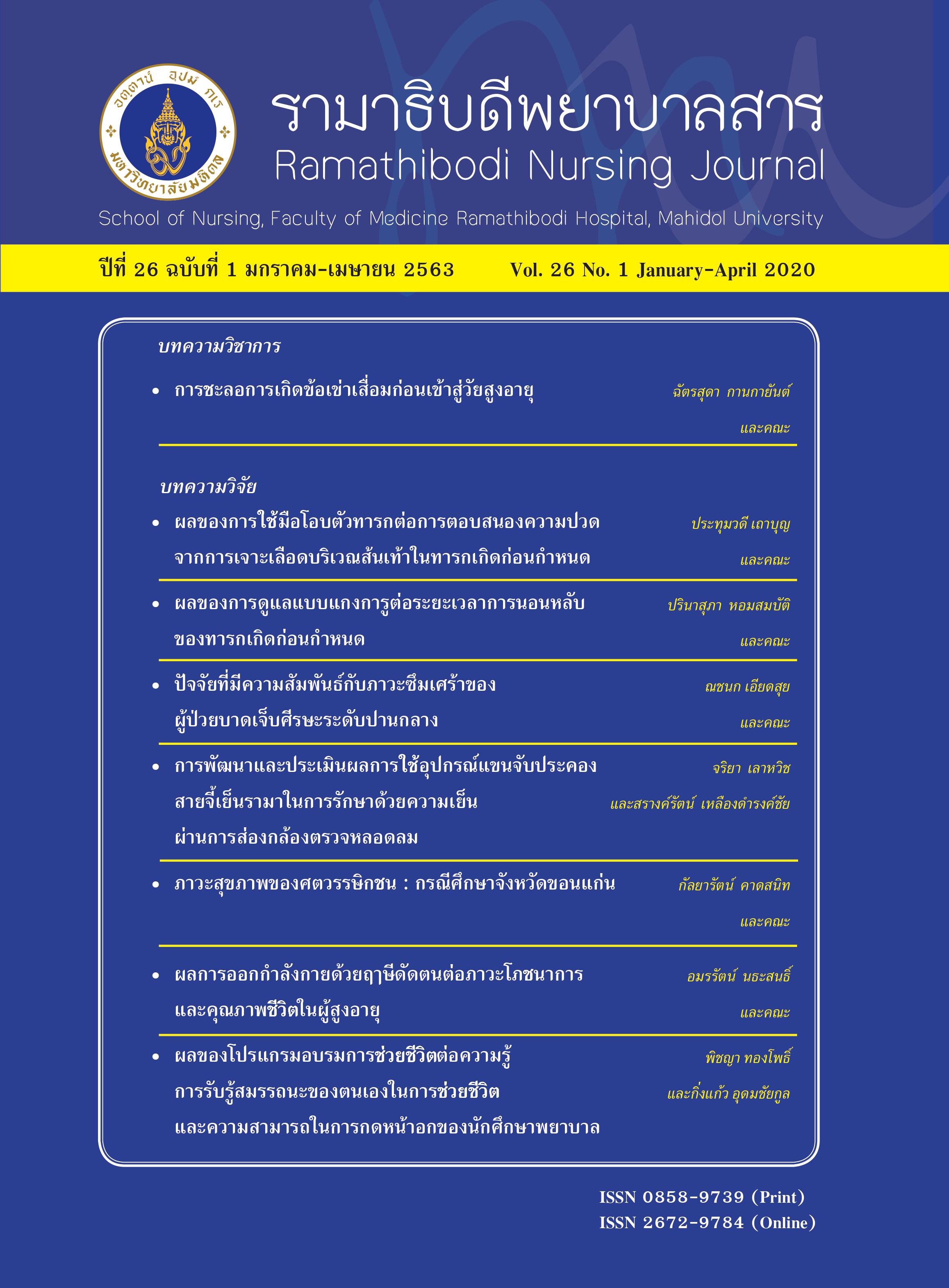ผลของการดูแลแบบแกงการูต่อระยะเวลาการนอนหลับของทารกเกิดก่อนกำหนด
Main Article Content
บทคัดย่อ
วัตถุประสงค์ของการวิจัย เพื่อเปรียบเทียบระยะเวลาการนอนหลับของทารกเกิดก่อนกำหนดขณะได้รับการดูแลแบบแกงการูกับการพยาบาลตามปกติ เป็นการวิจัยกึ่งทดลอง (quasiexperimental research) แบบข้ามสลับ (cross over design) กลุ่มตัวอย่างคือ มารดาและทารกคลอดก่อนกำหนด จำนวน 20 คู่ คัดเลือกแบบเฉพาะเจาะจง จากโรงพยาบาลมหาวิทยาลัยแห่งหนึ่งในจังหวัดปทุมธานี ระหว่างเดือนพฤษภาคม ถึง กันยายน พ.ศ. 2561 มารดาและทารกแต่ละคู่ได้รับการสุ่มให้อยู่ในเหตุการณ์ควบคุมหรือเหตุการณ์ทดลองในครั้งแรกและสลับในช่วงถัดไป ซึ่งการดูแลแบบแกงการูเป็นการอุ้มทารกแนบชิดอกให้ผิวหนังทารกสัมผัสกับผิวหนังมารดา ผู้วิจัยทำการบันทึกวีดิทัศน์ตลอดการทดลองเพื่อนำมาประเมินพฤติกรรมการนอนหลับของกลุ่มตัวอย่างตามคู่มือประเมินพฤติกรรมการหลับตื่นของทารกเกิดก่อนกำหนด วิเคราะห์ข้อมูลโดยใช้สถิติ paired t-test และ สถิติ Wilcoxon Signed-rank test ผลการศึกษาพบว่า ทารกเกิดก่อนกำหนด ขณะที่ได้รับการดูแลแบบแกงการูมีค่าเฉลี่ยระยะเวลาการนอนหลับนานกว่าขณะที่ได้รับการพยาบาลตามปกติอย่างมีนัยสำคัญทางสถิติ ซึ่งผลการวิจัยครั้งนี้สนับสนุนสมมติฐานการวิจัยและเป็นไปตามข้อเสนอขององค์การอนามัยโลกที่ให้การดูแลแบบแกงการูเป็นระยะเวลาไม่ต่ำกว่า 1 ชั่วโมงและควรทำการดูแลอย่างต่อเนื่องเพื่อประโยชน์สูงสุดของการดูแลแบบแกงการู
Article Details
บทความ ข้อมูล เนื้อหา รูปภาพ ฯลฯ ที่ได้รับการตีพิมพ์ในรามาธิบดีพยาบาลสาร ถือเป็นลิขสิทธิ์ของวารสาร หากบุคคลหรือหน่วยงานใดต้องการนำทั้งหมดหรือส่วนหนึ่งส่วนใดไปเผยแพร่หรือเพื่อกระทำการใด ใด จะต้องได้รับอนุญาตเป็นลายลักษณ์อักษรจากรามาธิบดีพยาบาลสารก่อนเท่านั้น
References
Bureau of Policy and Strategy, Ministry of Public Health.Vital statistics-birth database; 2012. [cited 2015 April
. Available from: https://bps.ops.moph.go.th/Healthinformation/statistic55/2.1.5_55.pdf (in Thai)
World Health Organization. WHO health statistics: A critical review the incidence of low birthweight. 2015.
[cited 2015 April 20]. Available from World Health Organization website: https:// www.who.int/news-room/
fact-sheets/detail/preterm-birth
Gardner SL, Lubchenco LO. The neonate and the environment: impact on Development. In: Gardner SL,
Merenstein GB, Editors. Handbook of neonatal intensive care. St Louis: Mosby; 1998.
Blackburn ST. Environment impact of the NICU on development outcomes. J Pediatr Nurs. 1998;13(5):279-89.
Lefrak L, Lund HC. Nursing practice in the neonatal intensive care unit. In: Klaus HM, Fanaroff AA, Editors.
Care of the high-risk neonate. Philadelphia: W. B.Saunders; 2001. p.223-42.
Srisawet S, Daramas T, Pookboonmee R. Effects of Mozart’s music on heart rate, respiratory rate, oxygen
saturation, and sleep duration of preterm infants.Ramathibodi Nursing Journal. 2013;19(2):221-34. (inThai)
Uplike. Music therapy result for ICU patients. Dimens Crit Care Nurs. 1990;9(1):39-45.
World Health Organization. Kangaroo mother care-a practice guide. Department of Reproductive Health and
Research. WHO, Geneva; 2003.
Messmer PR, Rodriguez S, Adams J, Well-Gentry J,Washburn K, Zabaleta I, et al. Effect of kangaroo care on
sleep time for neonates. Pediatr Nurs. 1997;23(4):408-14.
Ludington-Hoe SM, John MW, Morgan K, Lewis T, Gutman J, Wilson PD, et al. Neurophysiologic assessment of neonatal sleep organization: preliminary result of randomized, controlled trial of skin contact with preterm infant. Peds. 2006;117(5):e909-e23.
Feldman R, Weller Al, Eidelman AI, Sirota L. Skin to skin contact (Kangaroo care) promotes Self-regulation in
premature infant: sleep wake cyclicity, arousal modulation,and sustained exploration. Dev psychol. 2002;38:194-207.
Bastani F, Rajai N, Farsi Z, Als H. The effect of kangaroo care on sleep and wake states of preterm infants. J Nurs Res. 2017;25(3):231-39..
Ludington-Hoe SM. Evidence-based review of physiologic effect of kangaroo care. Curr Wom Health Rev. 2011;7 (3):1-11.
Dodd VL. Implications of kangaroo care for growth and development in preterm infants. JOGNN. 2005;34
(2):218-32.
McCain GC, Ludington-Hoe SM, JY, Hadeed AJ. Heart rate variability responses of a preterm infant to kangaroo care. J Obstet Gynecol Neonatal Nurs. 2005;34(6):689-94.
Johnston CC, Stevens B, Pinelli J, Gibbins S, Fillion F,Jack A, et al. Kangaroo care is effective in diminishing
pain response in preterm neonates. Arch Pediatr Adolesc Med. 2003;157(11):1084-88.
Feldmn R, Eidelman AI. Skin to skin contact (Kangaroo care) accelerate autonomic and neurobehavioral maturation in preterm infants. Dev Med Child Neurol. 2003;45:274-8.
Als H. Toward a synactive theory of development: Promise for the assessment and Support of Infant individuality. Inf Mental Health J. 1982;3(4):229-43.
Parmalee AH, Stern E. Development state in infants. In:Clemente C, Purpura DP, Mayer FE, Editors. Sleep and
maturing nervous system. London: Academic Press; 1972.p.199-214.
Charastong C. A study of sleep pattern in premature infants.Unpublished master thesis, Master of Nursing Science (Maternal and Child Nursing), Faculty of Graduate Studies, Mahidol University; 2001.
Salk L. The role of heartbeat in the relations between mother and infant. Sci Am. 1973;228 (5):24-9.

